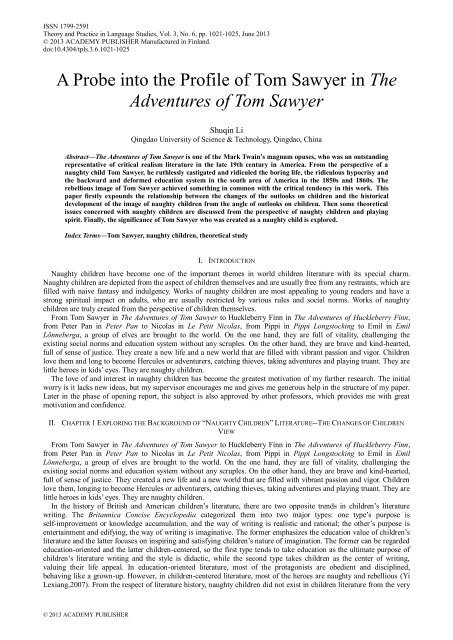Theory and Practice in Language Studies Contents - Academy ...
Theory and Practice in Language Studies Contents - Academy ...
Theory and Practice in Language Studies Contents - Academy ...
Create successful ePaper yourself
Turn your PDF publications into a flip-book with our unique Google optimized e-Paper software.
ISSN 1799-2591<strong>Theory</strong> <strong>and</strong> <strong>Practice</strong> <strong>in</strong> <strong>Language</strong> <strong>Studies</strong>, Vol. 3, No. 6, pp. 1021-1025, June 2013© 2013 ACADEMY PUBLISHER Manufactured <strong>in</strong> F<strong>in</strong>l<strong>and</strong>.doi:10.4304/tpls.3.6.1021-1025A Probe <strong>in</strong>to the Profile of Tom Sawyer <strong>in</strong> TheAdventures of Tom SawyerShuq<strong>in</strong> LiQ<strong>in</strong>gdao University of Science & Technology, Q<strong>in</strong>gdao, Ch<strong>in</strong>aAbstract—The Adventures of Tom Sawyer is one of the Mark Twa<strong>in</strong>’s magnum opuses, who was an outst<strong>and</strong><strong>in</strong>grepresentative of critical realism literature <strong>in</strong> the late 19th century <strong>in</strong> America. From the perspective of anaughty child Tom Sawyer, he ruthlessly castigated <strong>and</strong> ridiculed the bor<strong>in</strong>g life, the ridiculous hypocrisy <strong>and</strong>the backward <strong>and</strong> deformed education system <strong>in</strong> the south area of America <strong>in</strong> the 1850s <strong>and</strong> 1860s. Therebellious image of Tom Sawyer achieved someth<strong>in</strong>g <strong>in</strong> common with the critical tendency <strong>in</strong> this work. Thispaper firstly expounds the relationship between the changes of the outlooks on children <strong>and</strong> the historicaldevelopment of the image of naughty children from the angle of outlooks on children. Then some theoreticalissues concerned with naughty children are discussed from the perspective of naughty children <strong>and</strong> play<strong>in</strong>gspirit. F<strong>in</strong>ally, the significance of Tom Sawyer who was created as a naughty child is explored.Index Terms—Tom Sawyer, naughty children, theoretical studyI. INTRODUCTIONNaughty children have become one of the important themes <strong>in</strong> world children literature with its special charm.Naughty children are depicted from the aspect of children themselves <strong>and</strong> are usually free from any restra<strong>in</strong>ts, which arefilled with naive fantasy <strong>and</strong> <strong>in</strong>dulgency. Works of naughty children are most appeal<strong>in</strong>g to young readers <strong>and</strong> have astrong spiritual impact on adults, who are usually restricted by various rules <strong>and</strong> social norms. Works of naughtychildren are truly created from the perspective of children themselves.From Tom Sawyer <strong>in</strong> The Adventures of Tom Sawyer to Huckleberry F<strong>in</strong>n <strong>in</strong> The Adventures of Huckleberry F<strong>in</strong>n,from Peter Pan <strong>in</strong> Peter Pan to Nicolas <strong>in</strong> Le Petit Nicolas, from Pippi <strong>in</strong> Pippi Longstock<strong>in</strong>g to Emil <strong>in</strong> EmilLönneberga, a group of elves are brought to the world. On the one h<strong>and</strong>, they are full of vitality, challeng<strong>in</strong>g theexist<strong>in</strong>g social norms <strong>and</strong> education system without any scruples. On the other h<strong>and</strong>, they are brave <strong>and</strong> k<strong>in</strong>d-hearted,full of sense of justice. They create a new life <strong>and</strong> a new world that are filled with vibrant passion <strong>and</strong> vigor. Childrenlove them <strong>and</strong> long to become Hercules or adventurers, catch<strong>in</strong>g thieves, tak<strong>in</strong>g adventures <strong>and</strong> play<strong>in</strong>g truant. They arelittle heroes <strong>in</strong> kids‘ eyes. They are naughty children.The love of <strong>and</strong> <strong>in</strong>terest <strong>in</strong> naughty children has become the greatest motivation of my further research. The <strong>in</strong>itialworry is it lacks new ideas, but my supervisor encourages me <strong>and</strong> gives me generous help <strong>in</strong> the structure of my paper.Later <strong>in</strong> the phase of open<strong>in</strong>g report, the subject is also approved by other professors, which provides me with greatmotivation <strong>and</strong> confidence.II. CHAPTER 1 EXPLORING THE BACKGROUND OF ―NAUGHTY CHILDREN‖ LITERATURE--THE CHANGES OF CHILDRENVIEWFrom Tom Sawyer <strong>in</strong> The Adventures of Tom Sawyer to Huckleberry F<strong>in</strong>n <strong>in</strong> The Adventures of Huckleberry F<strong>in</strong>n,from Peter Pan <strong>in</strong> Peter Pan to Nicolas <strong>in</strong> Le Petit Nicolas, from Pippi <strong>in</strong> Pippi Longstock<strong>in</strong>g to Emil <strong>in</strong> EmilLönneberga, a group of elves are brought to the world. On the one h<strong>and</strong>, they are full of vitality, challeng<strong>in</strong>g theexist<strong>in</strong>g social norms <strong>and</strong> education system without any scruples. On the other h<strong>and</strong>, they are brave <strong>and</strong> k<strong>in</strong>d-hearted,full of sense of justice. They created a new life <strong>and</strong> a new world that are filled with vibrant passion <strong>and</strong> vigor. Childrenlove them, long<strong>in</strong>g to become Hercules or adventurers, catch<strong>in</strong>g thieves, tak<strong>in</strong>g adventures <strong>and</strong> play<strong>in</strong>g truant. They arelittle heroes <strong>in</strong> kids‘ eyes. They are naughty children.In the history of British <strong>and</strong> American children‘s literature, there are two opposite trends <strong>in</strong> children‘s literaturewrit<strong>in</strong>g. The Britannica Concise Encyclopedia categorized them <strong>in</strong>to two major types: one type‘s purpose isself-improvement or knowledge accumulation, <strong>and</strong> the way of writ<strong>in</strong>g is realistic <strong>and</strong> rational; the other‘s purpose isenterta<strong>in</strong>ment <strong>and</strong> edify<strong>in</strong>g, the way of writ<strong>in</strong>g is imag<strong>in</strong>ative. The former emphasizes the education value of children‘sliterature <strong>and</strong> the latter focuses on <strong>in</strong>spir<strong>in</strong>g <strong>and</strong> satisfy<strong>in</strong>g children‘s nature of imag<strong>in</strong>ation. The former can be regardededucation-oriented <strong>and</strong> the latter children-centered, so the first type tends to take education as the ultimate purpose ofchildren‘s literature writ<strong>in</strong>g <strong>and</strong> the style is didactic, while the second type takes children as the center of writ<strong>in</strong>g,valu<strong>in</strong>g their life appeal. In education-oriented literature, most of the protagonists are obedient <strong>and</strong> discipl<strong>in</strong>ed,behav<strong>in</strong>g like a grown-up. However, <strong>in</strong> children-centered literature, most of the heroes are naughty <strong>and</strong> rebellious (YiLexiang,2007). From the respect of literature history, naughty children did not exist <strong>in</strong> children literature from the very© 2013 ACADEMY PUBLISHER
















